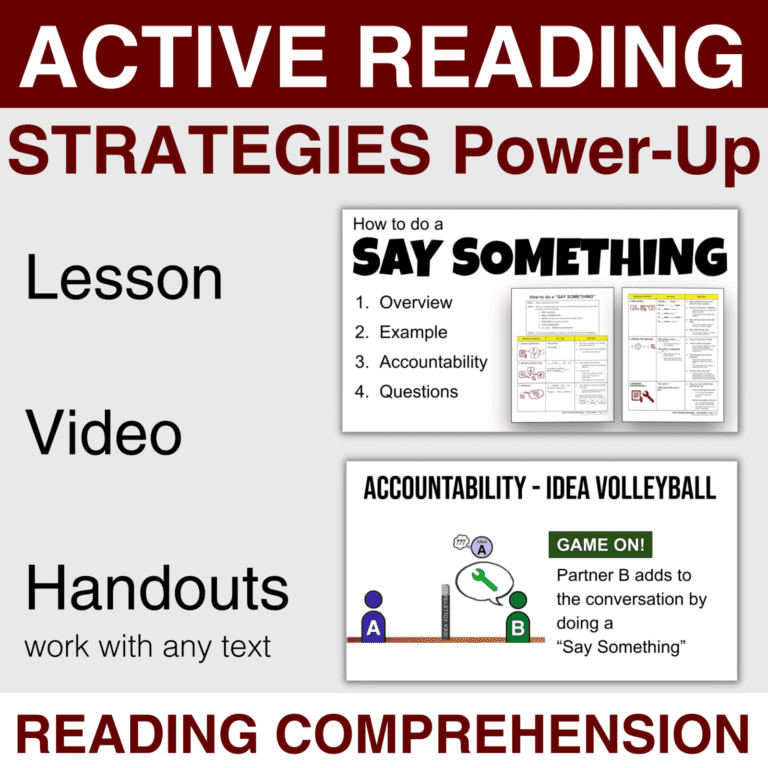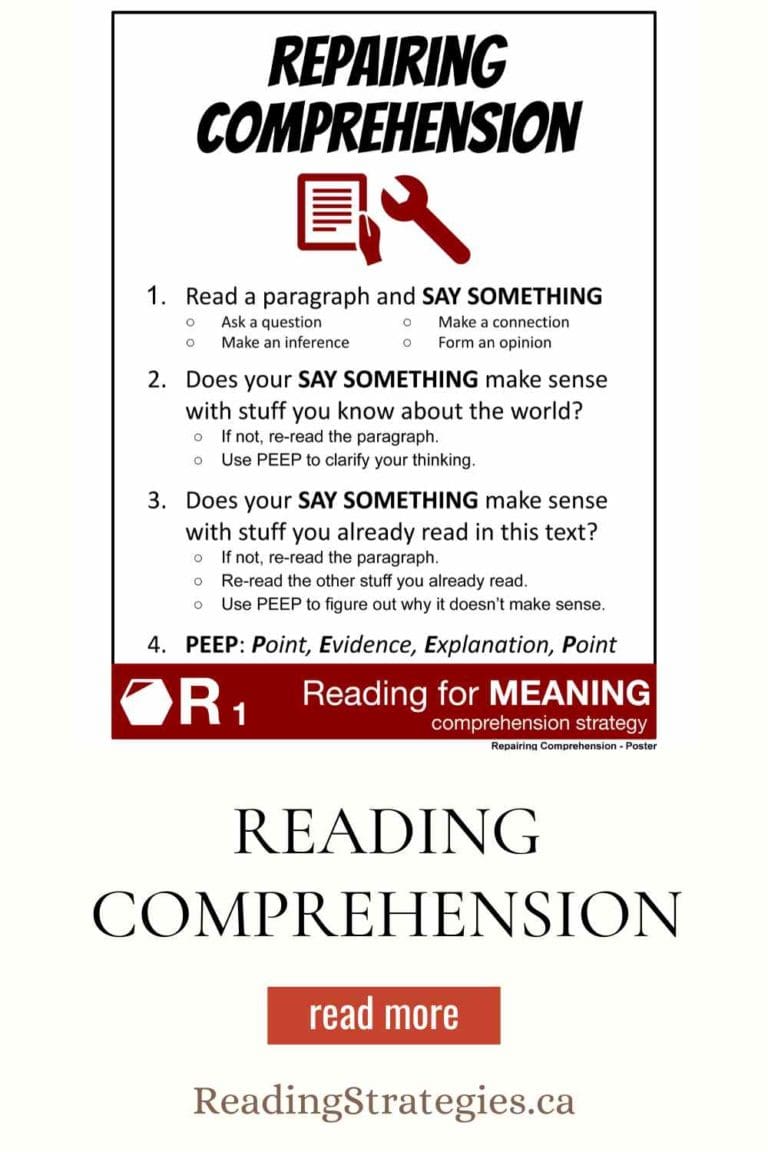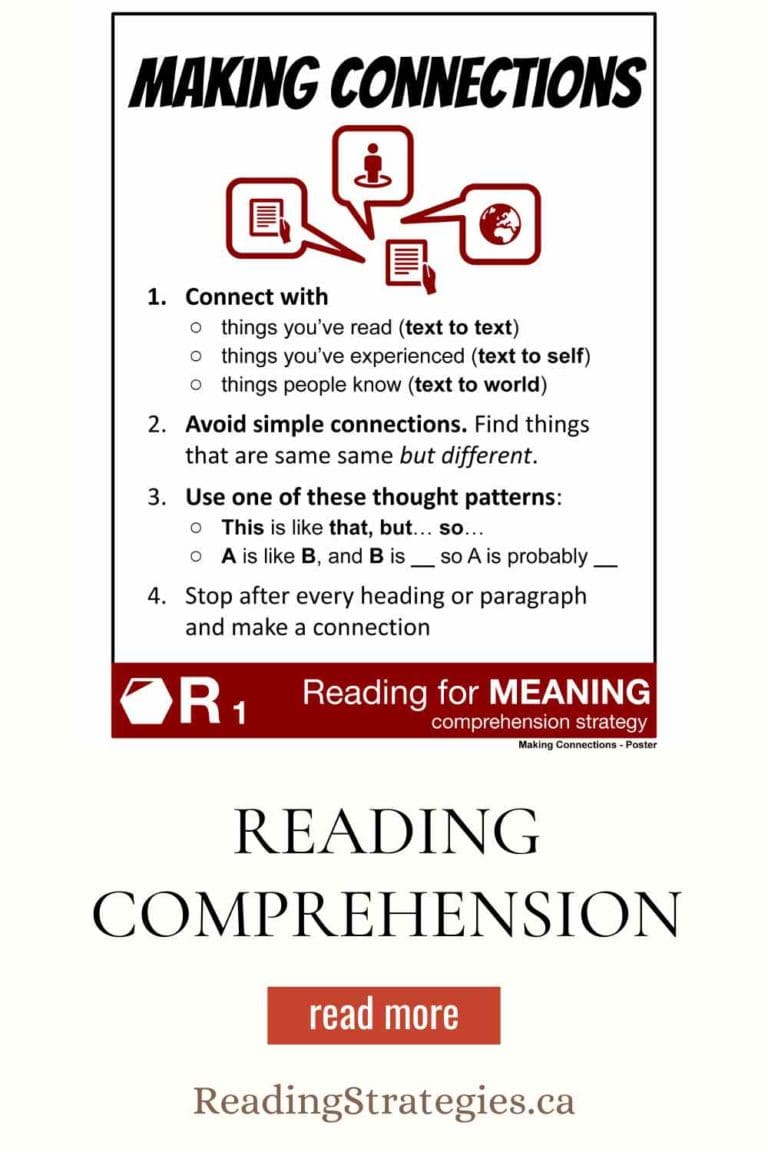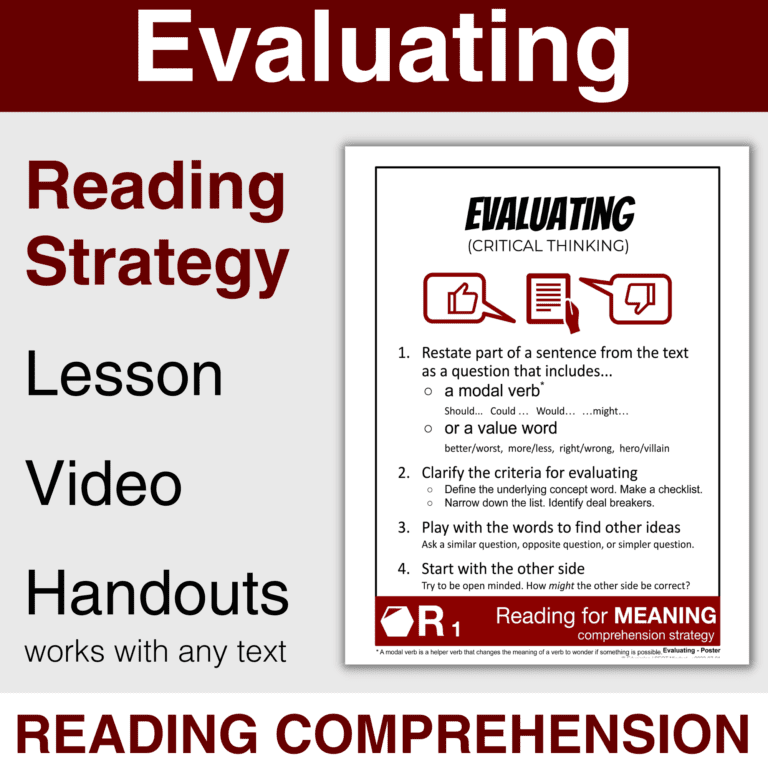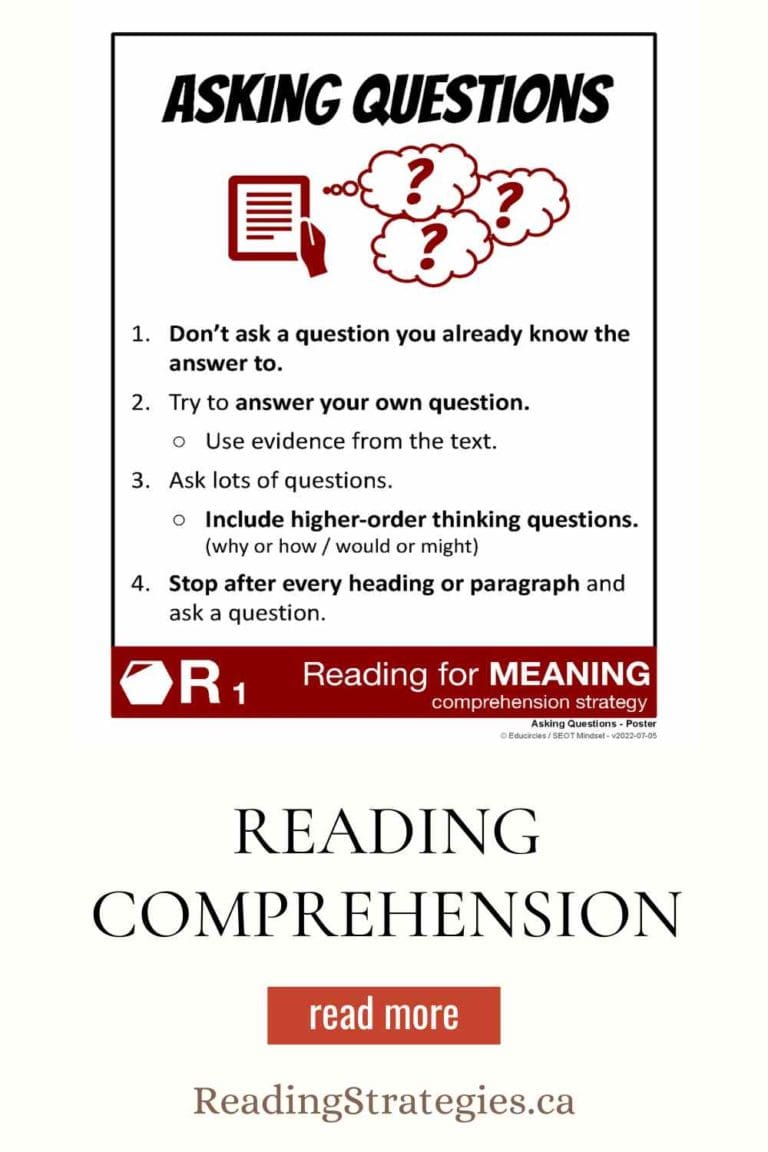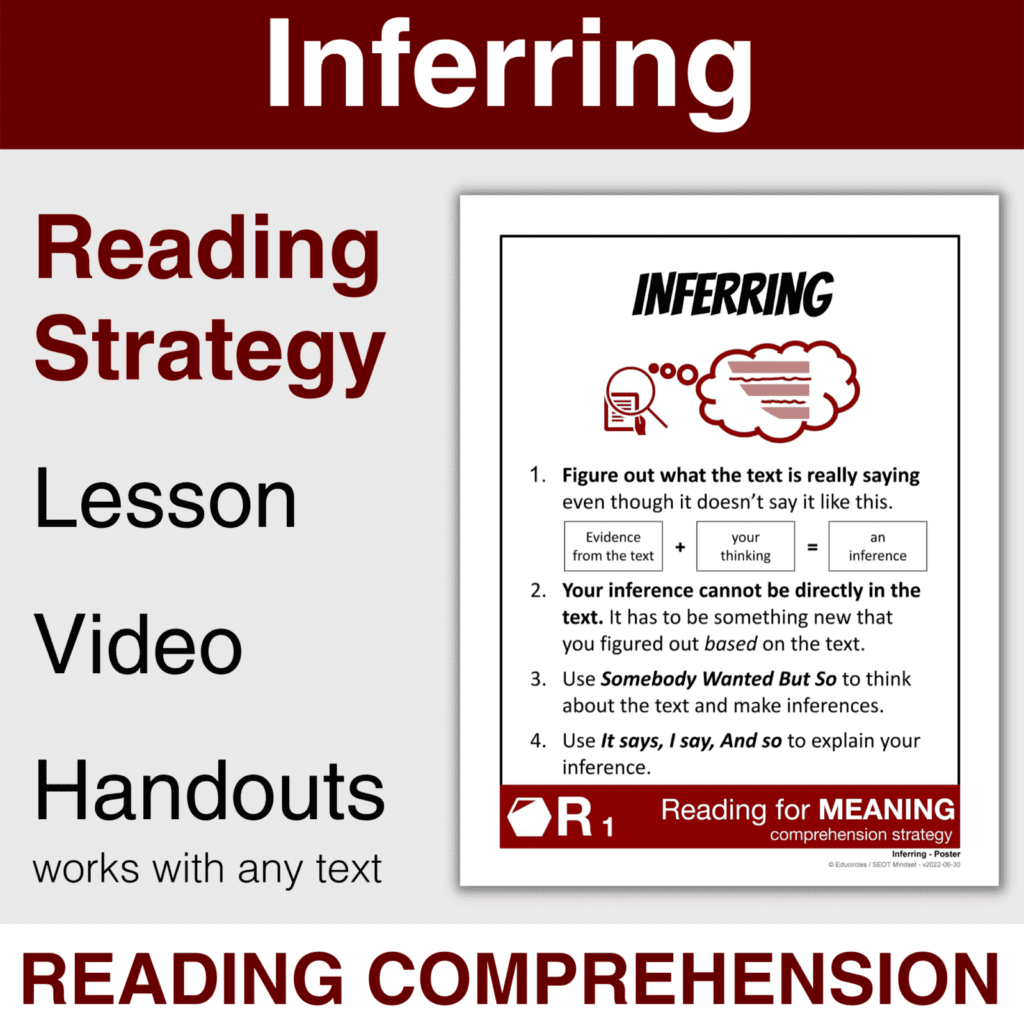
Inferring Reading Strategy – lesson plan UPDATE Mar 9, 2023 – If your students can infer hidden meaning in a text message, then they can probably infer hidden meaning in a narrative (novel).
Inferring is more than simply reading between the lines!
Use this lesson to help students develop stronger inferences by showing them HOW to develop an inference and HOW to check their inference to make it stronger.
INFERRING
Reading Strategy
How to Infer – 4 PRO TIPS to use the Inferring Reading Strategy
- Figure out what the text is really saying even though it doesn’t say it like this.
(Evidence from the Text + Your Thinking = an Inference) - Your inference cannot be directly in the text. It has to be something new that you figured out based on the text.
- Use Somebody Wanted But So to think about the text and make inferences.
- Use It says, I say, And so to explain your inference.
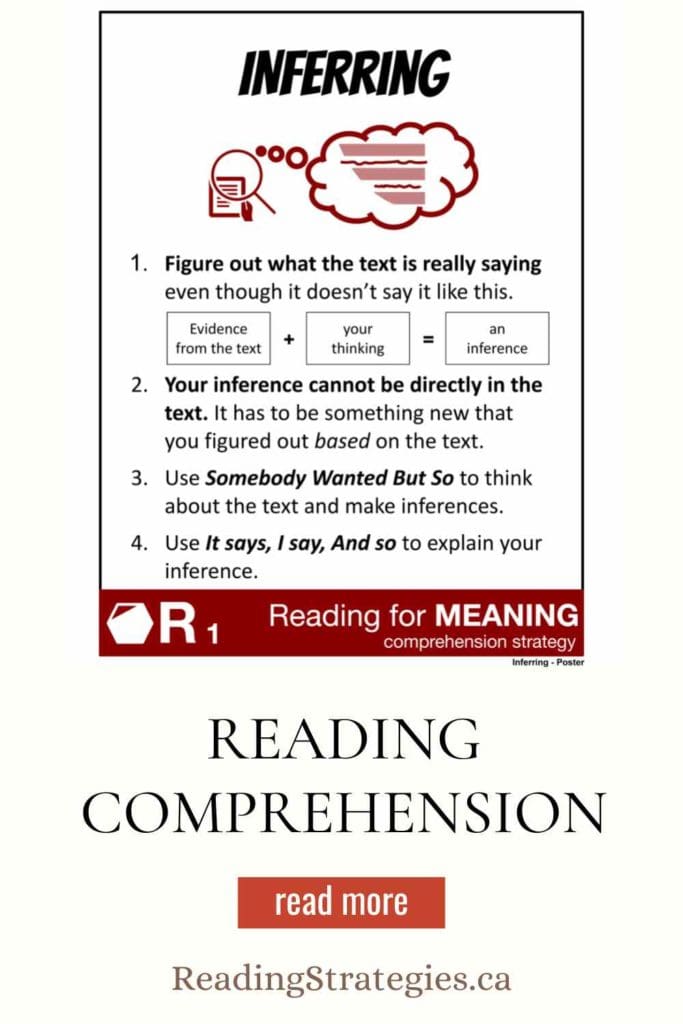
Here’s an inferring reading strategy example that your students will actually like.
Show students this screenshot of a text message conversation on a phone.
Then ask your students what’s going on. Do these people even like each other? How can you tell?
I bet your students will be quick to point out details and argue over little pieces of evidence to support their thinking:
- What the students actually said
- But, what it really means.
Then go through the rest of the inferring reading lesson to break down the inference reading strategy.
If your students can find hidden meaning in a text conversation, then let’s give them 4 PRO TIPS to transfer that skill to “boring” school work (like novels and textbooks.)
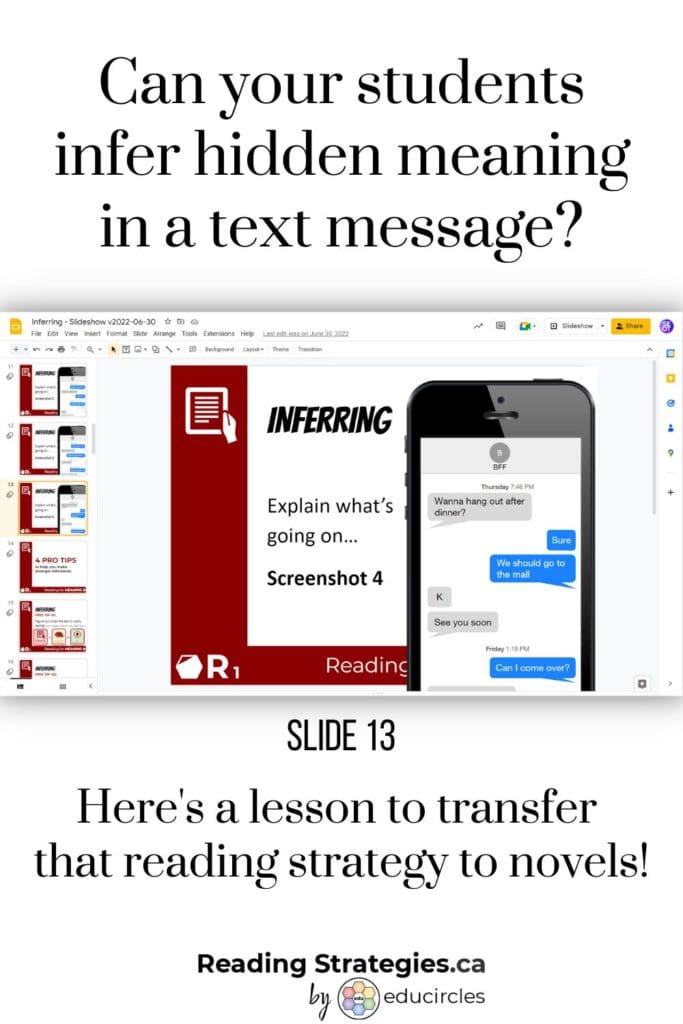
Help students develop stronger inferences by showing them HOW to come up with an inference, and HOW to check their inference to make it stronger.
This inferring reading strategy lesson is Distance Learning and 1:1 Google Classroom™ ready!
There’s more to inferring (or inferencing) than simply reading between the lines. Some inferences are better than others.
4 PRO TIPS to help your students develop STRONGER INFERENCES that are well supported by evidence in the text and their own thinking.
The slideshow lesson is comprehensive, easy to use and includes everything you need for :
- DISTANCE LEARNING or 1:1 LEARNING in Google Classroom
- FACE to FACE LEARNING in your real classroom
In this package, you get:
- strategy and an example of how to use this strategy..
- a generic INFERRING handout package that can be used with any text. This helps students ask questions before, during, and after reading.
- a metacognition handout/reflection questions to help students reflect on the strategy
- a rubric to assess ideas generated during reading, as well as ideas generated during the metacognition reflection.
BONUS VIDEO LESSON:
- I’ve recorded the slideshow lesson as a FREE YOUTUBE VIDEO so it’s easier to teach with DISTANCE LEARNING: https://youtu.be/qw0cd4VNpc4
- The text message inferring example used in this slideshow can be found here: https://youtu.be/T2JFG9pYa3g
IMPORTANT NOTE: This inferring reading strategy lesson DOES NOT include a text for students to read!
The package only includes the Inferring strategy slideshow lesson and handouts.
It is intended for teachers to use with a novel or text that they are studying in class.
If you would like to use the information text in this slideshow about “building bridges over dinner and a hockey game”, you can find the article here.
Reading comprehension strategies like this inferring reading strategy lesson help students engage with the text and gain a deeper understanding than just passively reading.
If you want this product with reading texts, please check out our Reading for Meaning Comprehension Strategies Bundle.
Watch the FREE Reading Comprehension Video.
Inferring Reading Strategy Lesson Plan
Before we get into this lesson, you should know that we are going to be doing some active reading.
This means that we think about the text as we read. Your brain needs to be ENGAGED. We are actively reading (instead of passively reading.)
Let’s try to use a Growth Mindset here. If we work hard and do certain things, we can get better at reading.
Comprehension strategies are tricks and things we can do to help us figure out the meaning of a text. Today, we’re going to be talking about a comprehension strategy called inferring. Sometimes, people call it inferencing or Making Inferences.
The goal of inferring is to figure out what the text is really saying even though the author doesn’t actually say it directly.
Some people call this reading between the lines.
- That doesn’t mean we’re literally reading invisible words between the printed lines of text in a book. (Although that would be super cool.)
- Reading between the lines is an expression that means we look for clues and hints in what’s written to figure out a hidden meaning or what’s really going on.
We make inferences all the time. When we read a book, chat with a stranger, watch the news or text with our friends.
Watch this video and explain what is really going on here.
Did you figure out what happened even though the text didn’t say it explicitly? That’s called inferring.
Inferring is when you
- take evidence from the text
- and you add your own thinking
- to figure out what’s really going on.
Let’s have a closer look at this text message thread.
Here we have screenshot #1 and the text message is from today.
The person with the Blue text messages says, “Want to hang out?” and the message was read today this morning at 10:33 AM
The person with the Grey text messages says, “Sure” but then right away says, “Wait, I can’t sorry,” and then the Blue person just says “K” – we know that the message was delivered but hasn’t been read by the Grey person yet.
Okay, so let’s think about this writing.
- It looks like the blue person wants to hang out but the grey person can’t.
- Maybe, the grey person’s really busy and can’t hang out right now, but why would they say “sure” first? Maybe they forgot they had something else they had to do?
Now let’s look at screenshot #2
It’s from yesterday in the afternoon at 2:40 PM and the blue person asks the grey person if they want to FaceTime, and the grey person says “sorry I’m a little busy.”
And then, the blue person right away says, “that’s fine”
- So it makes me wonder if the blue person really is okay with it
- Maybe they just automatically said, “that’s fine” kind of how when we see people we say, “how are you?” and the other person automatically says, “good, how about you?” but that doesn’t mean they’re actually fine.
And at the bottom, we can see today’s message from Screenshot #1 where the Blue Person is asking if the grey person wants to hang out.
So I don’t know. Maybe the blue person’s bored and they just want to hang out.
But I also see up at the top it says BFF as the contact name
- I know that no one’s name actually has the initials BFF (although that would be cool)
- so probably when the Blue Person was putting their friend’s phone number into their contacts, instead of putting their friend’s first name and last name, they put in BFF as the first name because they’re really good friends.
- The BFF has to be the person in grey. Because the person on the right is the person who owns the phone, so it’s like we’re pretending to be the Blue Person here texting our BFF.
But it’s been twice where the best friend said they were too busy which seem odd if they’re best friends. Maybe the blue person thinks the grey person is their BFF but it’s one sided?
Let’s look at screenshot #3
Now we can see it’s from Friday,
- which means when it says “yesterday” that must’ve been Saturday,
- which means that today must be Sunday
Okay, so back on Friday in the afternoon around 1 in the afternoon
- the blue person asks if they can come over
- and the grey person right away says, my mom says no
- Then the blue person asks if the grey person want to hang out at their place.
- Then there’s no response for about an hour and then the grey person says sorry can’t.
Okay, so if I think about these three screenshots together, I know this blue person’s asking a lot of times if the Grey person want to hang out and the Grey person keeps saying no.
- maybe the blue person is getting tired of asking or feeling brushed aside because normally, they write a short sentence, but on screenshot #1, it was just a one letter answer: K.
We also don’t really know what’s going on with this Grey person and why they said no.
- They said their mom said no, but if these people are in College, maybe the Grey person doesn’t live with their mom, so then that might be an obvious line about not wanting to hang out?
- Or maybe, this Grey person is in grade 8 and their mom really doesn’t want them to hang out with the Blue person.
Okay, let’s look at screenshot #4
This is from Thursday and it’s the start of all of this drama.
So this was the day before screenshot #3 and the Grey person is starting the conversation this time and asking the Blue person if they want to hang out after dinner.
Then the blue person right away says sure and suggests going to the mall and the Grey person responds right away with “K see you soon” – I know the grey person said it right away because there’s no date stamped in the text chat.
The conversation on Thursday is different from the other screenshots because it’s going back and forth so now it looks like they’re actually friends as opposed to the next 3 days where it’s just the Blue person asking to hang out.
So that makes me wonder what’s going on? It’s Thursday night in the evening. Did something happen?
And depending on your life experiences, personal knowledge and age, you might have different ideas about what happened Thursday night. There are lots of different guesses that we could make here.
Let’s look at a couple of pro tips to think about when we are inferring
Inferring Reading Strategy – PRO TIP #1: Figure out what the text is really saying…
Figure out what the text is really saying even though it doesn’t actually say it like this in the writing.
That means, we look for evidence from the text and we combine it with own thinking and together that makes an inference. It’s kind of like a formula:
evidence + thinking = inference.
It’s important to note here that when we say find evidence in the text, we really mean find evidence or clues in whatever we’re talking about.
Remember, we make inferences all the time – whether we’re chatting with a friend in person, reading a novel, watching a movie, or deciding to buy something online.
Even though in the previous example, we were literally talking about “texts” as in “text messages”, when we talk about finding evidence in the text, we could be looking for clues in what a person says to us, a paragraph that an author wrote in a book, a lyric in a song, a line in a movie, etc.
You get the idea.
Inferring Reading Strategy – PRO TIP #2: Make sure the inference is NOT directly stated
Your inference cannot be directly stated in the text.
So if your inference is literally, directly written in the book, then it’s a direct message from the author and not an implied message or hidden nuance that you figured out based on what the author wrote.
Inferring Reading Strategy – PRO TIP #3: Somebody Wanted But So
Sometimes when we’re reading and someone asks us to make an inference, it can be hard to come up with something to say.
Try using the classic strategy Somebody Wanted But So to come up with something to say.
- Figure out a character from the text.
- Figure out what they wanted (or didn’t want.)
- Figure out what went wrong or what an obstacle was,
- and figure out what the person did as a result.
You need to come up with all 4 parts.
Let’s look at some examples from our text message activity.
- The Blue person
- wanted to hang out with the Grey person,
- but the Grey person was busy
- so the Blue person felt sad and ditched.
Here’s another example:
- The grey person
- didn’t want to hang out with the blue person,
- but they also didn’t want to hurt the blue person’s feelings by saying it to their face,
- so the grey person just lied and said they were busy or came up with another excuse.
Somebody wanted but so can be about the main characters in the text, but it can also be about someone who is just mentioned in passing. For example,
- the mom
- didn’t want their kid (the grey person) to hang out with the blue person,
- but the grey person really wanted to hang out with their best friend,
- so the mom said no, you can’t hang out with the blue person.
Inferring Reading Strategy – PRO TIP #4: It Says, I Say, And So
Use the classic strategy “It says, I say, and so” to help you explain your inference or come up with a new understanding. For example,
- it says on screenshot #1 K and it also says BFF which is the contact name at the top
- I say K is a really short answer for the blue person because we know the blue person normally writes out complete words and sentences. I also know that if I’m feeling a little emotional, I don’t really say much either.
- And so maybe the blue person is feeling rejected because their BFF doesn’t like them anymore.
Here’s another example,
- the blue person in the text on screenshot #3 says can I come over and the grey person says my mom says no, and this happened on Friday at 1:18 PM
- I say that we normally have school at this time in the afternoon unless it’s summer and mom said no pretty quickly, so she must be nearby. The grey person wouldn’t have had time to text her and then respond to the Blue person because there was no timestamp between messages. The Blue person asked the question and right away the Grey person says their mom says no,
- And so maybe this text conversation took place during summer holidays. Or maybe it’s during the school year and the Grey person is sick at home and Mom works from home… but that’s probably not it because Friday afternoon, wouldn’t the Blue person be in class? They wouldn’t ask to come over to the Grey person’s house.
Another example of and it says, I say and so is
- On screenshot #4, the Grey person asks the Blue person on Thursday at 7:46 PM to see if they want to hang out after dinner…. And then the next message is made the next day on Friday at 1:18 PM when the Blue Person asks if they can come over
- I say the Grey person started texting first on Thursday and in the other 3 screenshots, the Blue person starts the conversation first? So on Thursday, it looks like they’re friends because the conversation goes back and forth. Is the mall even open at night? Did they even go to the mall?
- And so maybe something happened Thursday night and now the Grey person is mad. Or maybe the Grey person and the Blue person did something and got in trouble, so now the Grey person is grounded by their mom.
Okay practice time
Here’s the beginning of an informational text. The title says “Building bridges over dinner and a hockey game”
Let’s make an inference. Not sure where to start? No problem.
- Either you come up with a “Somebody Wanted But So” to say something about the text…
- Or come up with an “It says, I say and so” to figure out something new.
Let’s start with It says, I say, and so – For example,
- it says building bridges,
- I say you build a bridge to get from one side of a river to the other side
- and so this doesn’t make sense. Like, how do you even physically go over dinner and a hockey game? You can’t build bridges over people’s houses…
It’s important to remember that our first inferences may not be right. At this point we’re just trying to make reasonable guesses based on the clues we have so far.
If something doesn’t make sense, look for more clues in the text or try a different idea.
Ok, so let’s try to make another It Says, I Say, And So…
- I say that you eat dinner, you play hockey, and sometimes you can have family friends over for dinner
- and so maybe you’re building bridges (like some sort of popsicle stick craft or building activity). I don’t know – maybe it’s like family board game night and you’re trying to build a tower, and this is over dinner and the hockey game is on the TV in the background.
- To back this up with evidence from the text, it says building bridges over dinner.
When you do an It says, I say, And so…
- You can start in any box. You don’t have to go in order.
- You can also change your thinking as you get more information. Remember, we’ve only read the title of this article so far.
Pro tip #1 is about figuring out what the text is really saying even though it doesn’t say it like this. Remember that “evidence from the text” + “your own thinking” = “an inference”
- We need clues from the text – so in this example, “over dinner”
- and we combine that with our own thinking like: we know that we eat dinner and we know that we’ve had family friends over for dinner before.
- And so this is where the inference comes up – like maybe something happened during family board game night
Pro tip #2 is about checking to make sure your inference isn’t already directly stated in the text.
It has to be something new that you figured out based on what’s written in the text.
So let’s double check our thinking here. What we’ve read so far doesn’t say anything about family board game night, so we’re good.
Okay, now, let’s take a step back and come up with a Somebody Wanted But So to think about this text
- Some friends
- wanted to hang out and have dinner,
- but it was during Covid 19 lockdown
- so, they can’t hang out.
Okay, so an inference is when we figure out what the text is really saying even though it doesn’t say it like this
Let’s check our thinking…
- we have evidence from the text: It says “building bridges over dinner”
- and we combined that with our own thinking and ideas. Covid-19 is fresh in my mind so maybe this has something to do with physical distancing restrictions. I can’t hang out with my friends like I used to during Covid-19.
- So, we’re coming up with some inferences and figuring out some possibilities about what is going on in this informational text, even though the author doesn’t come out and tell us this.
We also need to check to make sure our inference isn’t directly in the text. It has to be something we figured out based on clues in the way it was written.
So in this example,
- it doesn’t say anything in the title about friends wanting to hang out
- and it also doesn’t say anything about Covid 19 stopping them.
So these are both inferences.
Be careful…
Just because we infer something doesn’t mean our inference is correct.
Strong inferences are supported by lots of strong evidence from text.
- So this text may have nothing to do with Covid 19
- In fact, this text may not even be about friends.
As we read, we’re actively looking for more clues and evidence from the text to either support our inference or to challenge them.
If the text doesn’t go on to talk about Covid-19, then maybe we need to change our inferences based on the new information we get as we read.
More practice – your turn
PK Sue- BAN has been helping to build bridges between police officers and disadvantaged youth by creating opportunities for the two groups to hang out with each other in positive ways
What are 2 strategies we can use to help us make an inference?
- Either Somebody wanted but so
- or it says I say and so
Let’s start with an “It says, I say and so”
- Create your own “it says I say and so” statement about this paragraph that we just read.
- Remember, you can start in any box.
Okay, now that you’ve come up with an “it says I say and so”, let’s figure out what the text is really saying even though it’s not obvious.
What’s the formula for an inference? What do we need when we make an inference?
- evidence from the text
- plus your own thinking
- equals an inference
Let’s double check our work right now:
- Do you have a small quote or a phrase for your “It Says.”
- Does this phrase come directly from the text.
- Did you explain what you already know from your life experience or did you explain what you think?
- Finally, did you figure out something implied, even though the text doesn’t explicitly come out and say it like this. In other words, did you make an inference?
What do we do to double check our inference?
- Make sure our inference is not directly in the text
- It has to be something new that we figured out based on the text
Double check right now to make sure your inference isn’t directly stated in the text.
Be careful!
- Remember that as we read, we’re looking for more clues from the text to support or refute our inferences here.
Here’s the next paragraph.
- Is there anything here that supports the inferences you made earlier?
- Is there anything here that suggests a different idea, especially when you combine it with things that we read earlier in the article?
Subban plays defence for the New Jersey Devils. Every home game, he hosts four guests to a nice dinner and great seats to watch his team play hockey. He’s a great host and chats with his guests before and after the game right.
Let’s review inferring as a reading comprehension strategy.
- Pro tip #1 Figure out what the text is really saying even though it doesn’t come out and say it like this. Remember that evidence from the text + your own thinking = an inference.
- Pro tip #2 Your inference cannot be directly in the text. It has to be something new that you figured out based on the text – so something implied by the text.
- Pro tip #3 Use the strategy Somebody Wanted But So to help you say something about the text.
- Pro tip #4 Use this strategy, It says I say And so to figure out something new.
PART 3
Reading for Meaning is one of the many strategies and skills we use when we read.
We don’t know what tomorrow will look like! Reading and understanding the implications of things is an important skill to help us survive and thrive in today’s changing world.
One thing that will help us get through today’s reading challenges and tomorrow’s tough obstacles is our character.
One way to work on character is to try to shift into a growth mindset. This means putting in the work, trying different strategies when we get stuck, and learning from our mistakes.
So, struggling through a text, reading for deeper meaning and reflecting on the strategies we use is an opportunity for us to develop character.
